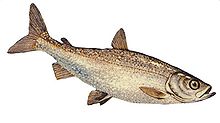Coregonus hoyi
| Bloater | |
|---|---|
 |
|
| Scientific classification | |
| Kingdom: | Animalia |
| Phylum: | Chordata |
| Class: | Actinopterygii |
| Order: | Salmoniformes |
| Family: | Salmonidae |
| Genus: | Coregonus |
| Species: | C. hoyi |
| Binomial name | |
|
Coregonus hoyi (Milner, 1874) |
|
| Synonyms | |
|
Argyrosomus hoyi Milner, 1874 |
|
Argyrosomus hoyi Milner, 1874
Coregonus hoyi (bloater) is a species or form of freshwater whitefish in the family Salmonidae. It is a silvery-coloured herring-like fish, 25.5 centimetres (10.0 in) long. It is found in most of the Great Lakes and in Lake Nipigon, where it inhabits underwater slopes. This fish is not to be confused with the extinct deepwater cisco (Coregonus johannae), a large fish that shared a common name with the bloater.
The bloater is a small, silvery-coloured whitefish with a pink and purple iridescence. It has a greenish tinge above, and a whitish belly. It is very similar to the kiyi, from which it may be distinguished by its lighter upper lip and smaller eye. Its body is deepest at its middle, it has small and pale fins, and it has 40–47 long gill rakers. The discoverer of the bloater, P. R. Hoy, thought it to be "the most beautiful of the white fish". It reaches a maximum total length of 37.0 centimetres (14.6 in) and commonly is 25.5 centimetres (10.0 in).
The bloater is native to all of the Great Lakes (except Lake Erie) and in Lake Nipigon. Across its range it is in decline, and it is listed as Vulnerable to global extinction by the IUCN Red List. It was extirpated in Lake Ontario and is extirpated in Lake Nipigon, is uncommon in Lake Michigan and is in decline Lakes Superior and Huron. This decline is caused mostly by predation by the alewife, and also by sea lamprey predation and pollution.
However, efforts to re-introduce the species in to Lake Ontario have been met with great success. Multiple North American fishery agencies have aided in the bloater's return to the lake, due to the positive impact it could have on its food web. Recent studies have shown that this fish has made a surprising comeback, and it is now re-established in Lake Ontario. State, provincial and federal agencies aim to stock 500,000 Coregonus hoyi into Lake Ontario by the year 2015.
...
Wikipedia

